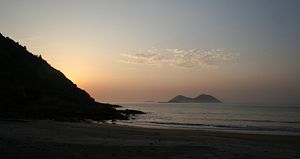China’s People’s Liberation Army Air Force (PLAAF) on Sunday flew more than 40 aircraft through the Miyako Strait in the East China Sea, prompting the Japanese Air Self-Defense Force (JASDF) to scramble a fighter in response. The Chinese aircraft flew on to the West Pacific.
The Chinese deployment was part of a “routine drill,” according to a spokesperson for the Chinese Ministry of Defense.
Shen Jinke, a PLAAF spokesperson, noted that the 40 aircraft were of “various types” and included H-6K bombers, Su-30 fighters, and air tankers. The drill involved the exercise of “reconnaissance and early warning, attacks on sea surface targets, and in-flight refueling to test the Air Force’s fighting capacity on the high seas.”
A report by Xinhua, China’s state news agency, added that the PLAAF contingent also “conducted routine patrol in the East China Sea Air Defense Identification Zone (ADIZ).” China declared an ADIZ in the East China Sea in November 2013, drawing sharp criticism from Japan and other regional states.
Shen added that the drills and the transit through the Miyako Strait were conduct “in accordance with the needs of the Air Force to defend national sovereignty and security, as well as to maintain peaceful development.”
The Japanese Ministry of Defense, in a statement cited by Kyodo news agency, noted that the Chinese aircraft did not infringe Japanese territorial air space, which is defined as corresponding to the 12 nautical mile territorial waters accorded to coastal states by international law.
Japan regularly scrambles jets in response to Chinese military aircraft near its sovereign airspace in the East China Sea, where the two countries are mired in a dispute over the sovereignty of the Senkaku/Diaoyu Islands. The islands are administered by Japan and claimed by China.
In 2015, the JASDF intercepted Chinese aircraft 571 times.
The PLAAF’s latest drills through the Miyako Strait follow a recent exercise in the Bashi Channel, the strategically vital waterway between the Philippines’ northern island of Luzon and Taiwan.
Running between Miyako Island and Okinawa Island in Japan’s Okinawa Prefecture, the Miyako Strait is just wide enough to accommodate an international waterway through Japan’s exclusive economic zone.
The Bashi Channel and Miyako Strait bear considerable strategic importance for the PLAAF and People’s Liberation Army-Navy (PLAN) as they permit China access to the Western Pacific beyond what Chinese strategists have called the first island chain, a set of islands running from the Kuril Islands in the Sea of Japan to the Philippines and Borneo.
In addition to recent PLAAF activity in the Bashi Channel and Miyako Strait, the PLAN and China Coast Guard have increased their activity in the East China Sea as well.
Earlier this summer, for example, a Chinese Navy vessel entered the contiguous waters of the Senkaku/Diaoyu Islands for the first time ever.

































